Upload other documents, orders or bundles
Updated 26 November 2025
1. Before you start
Before you can use family public law services using MyHMCTS, you and your organisation must have completed these steps:
1. Set up an HMCTS Payment by Account, so that you can pay any relevant fees. 2. Register your organisation with MyHMCTS. 3. Set up your MyHMCTS user account.
Read the MyHMCTS registration guidance for further information and instructions. If your organisation already has an account, contact your administrator to get your account set up.
Once you have a MyHMCTS account, you can sign in using your email address and password.
Visit MyHMCTS: how to complete case administration tasks for guidance on case administration tasks, such as:
- sharing a case
- assigning a case
- filing a notice of change or acting
You should only upload
- documents needed for the case according to the rules
- statements
- assessments
- expert reports
Do not upload
- police disclosure notices – these should be uploaded following the hearing as a separate order
- orders with a power of arrest – these should be provided to the police
Case file view
How documents appear in case file view depends on when they were uploaded. Those uploaded:
- from 23 July 2024 will appear in reverse chronological order and display upload date and time
- before 23 July 2024 will appear in alphabetical order without the upload date and time
2. Upload a draft or agreed order
You must add all documents and orders to the case using MyHMCTS. Do not send any documents by email unless you have been asked to by a judge, or if the order is confidential.
If the order is confidential, email it to contactfpl@justice.gov.uk. You must make it clear in the email what is confidential and who it is confidential from.
Upload a draft case management order
You can upload a draft case management order (CMO) before the hearing.
1. Open the case and select ‘Upload draft orders’ from the next step dropdown menu. Then select ‘Go’.
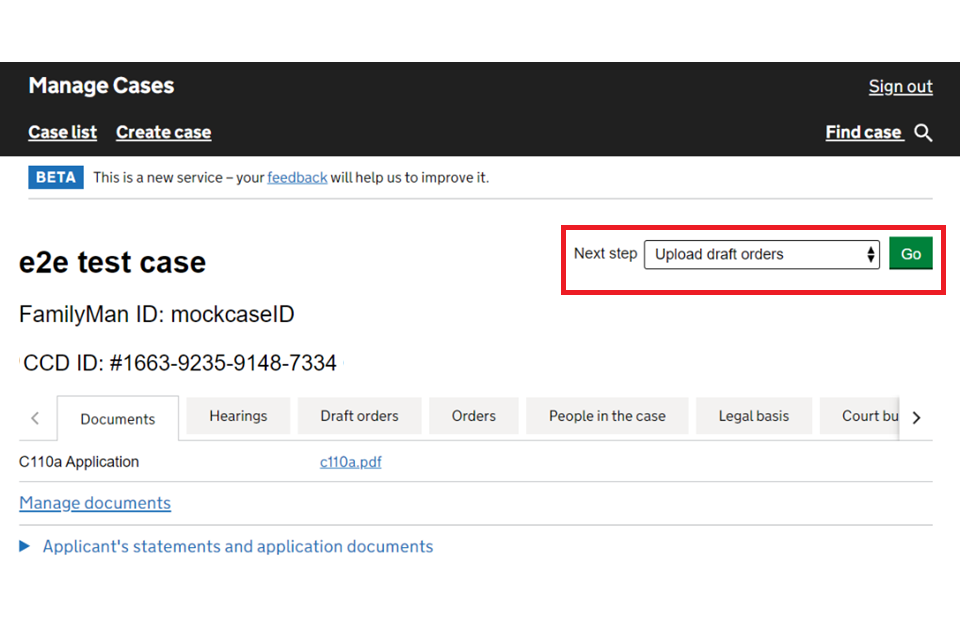
2. Select ‘Case Management (CMO)’ and ‘Continue’. Do not add an additional order at this stage – you can add additional orders later if required.
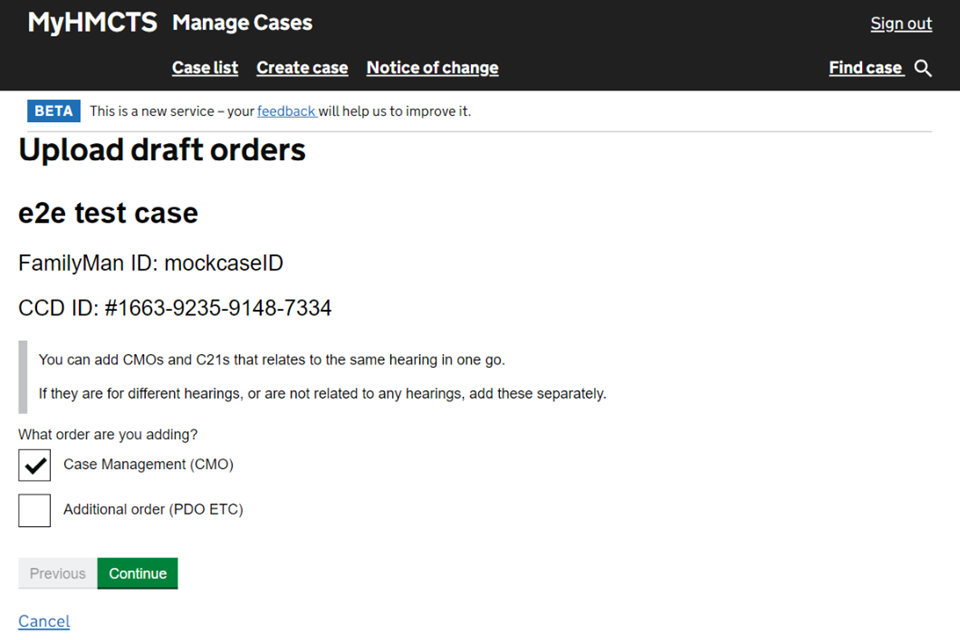
3. Select the draft CMO option, then choose which hearing the CMO relates to from the dropdown menu.
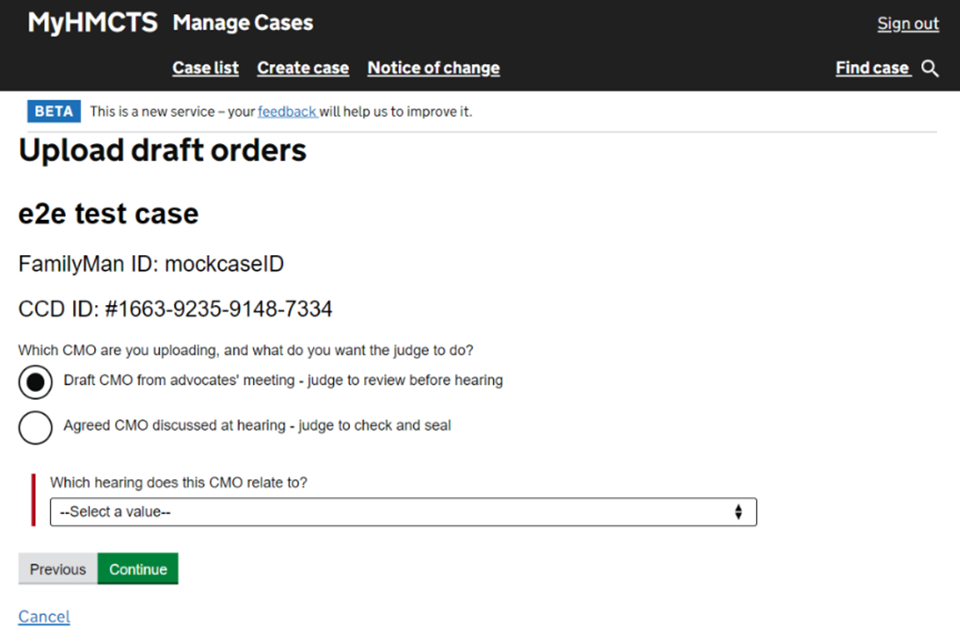
4. Select ‘Choose file’ to browse for the draft CMO document. Then select ‘Continue’.

5. Select whether a translation is needed. You will see the name of the hearing judge that the order will be sent to. Select ‘Continue’.
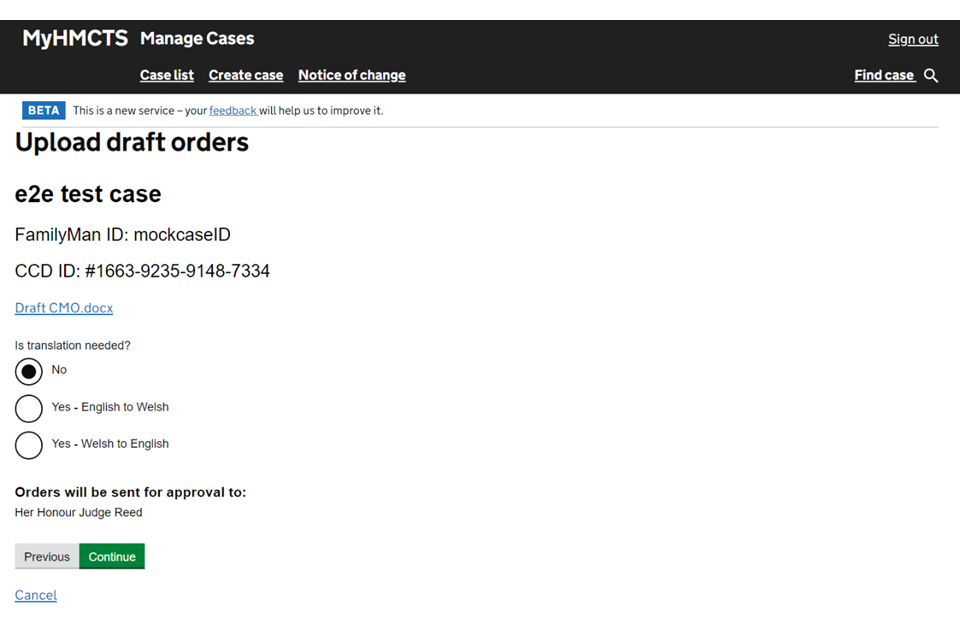
6. Check your answers. If you need to make any changes, select ‘Change’ next to the information you need to amend. When the information is all correct, select ‘Submit’.

The hearing judge will receive a notification telling them the draft order is available to view. This is not the order they will approve – you must upload an agreed order following the hearing for the judge’s approval.
Upload an agreed order for judicial approval
1. Open the case and select ‘Upload draft orders’ from the next step dropdown menu. Then select ‘Go’.
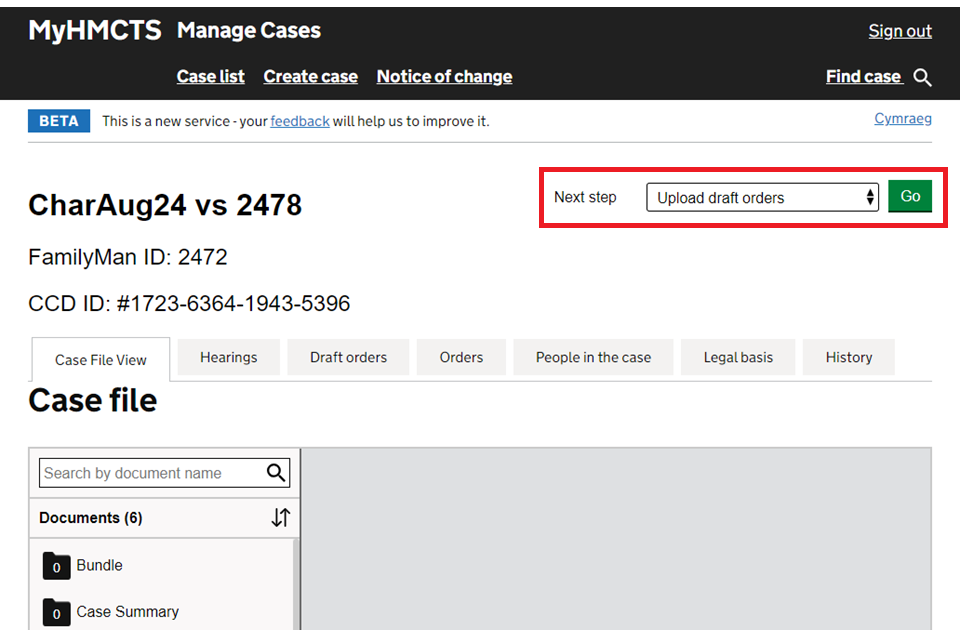
2. Select the relevant order then ‘Continue’. If you have more than one order that relates to the same hearing, tick both case management and additional order.
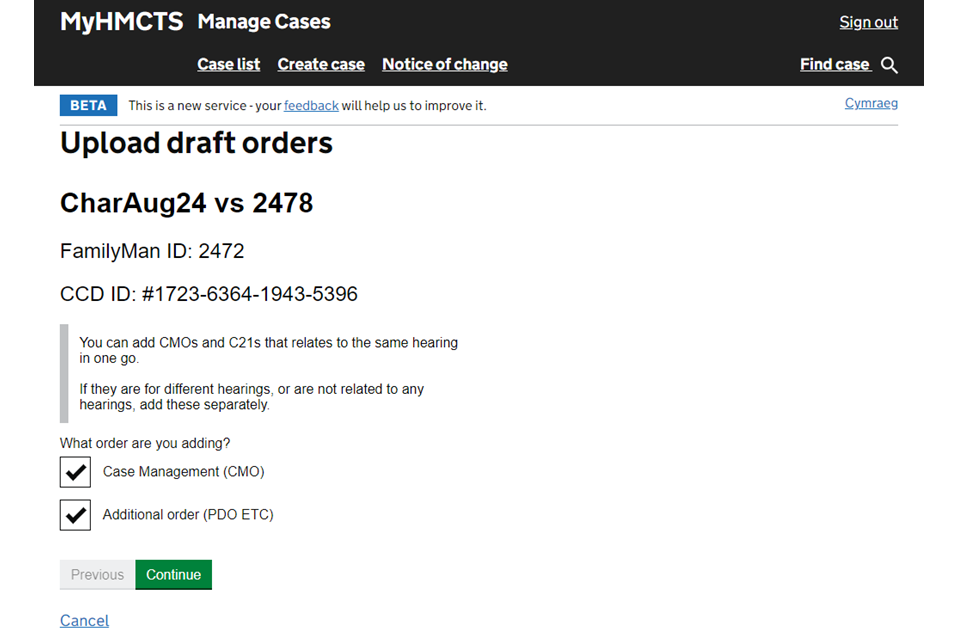
3. Select the agreed CMO option, then choose which hearing the CMO relates to from the dropdown menu.
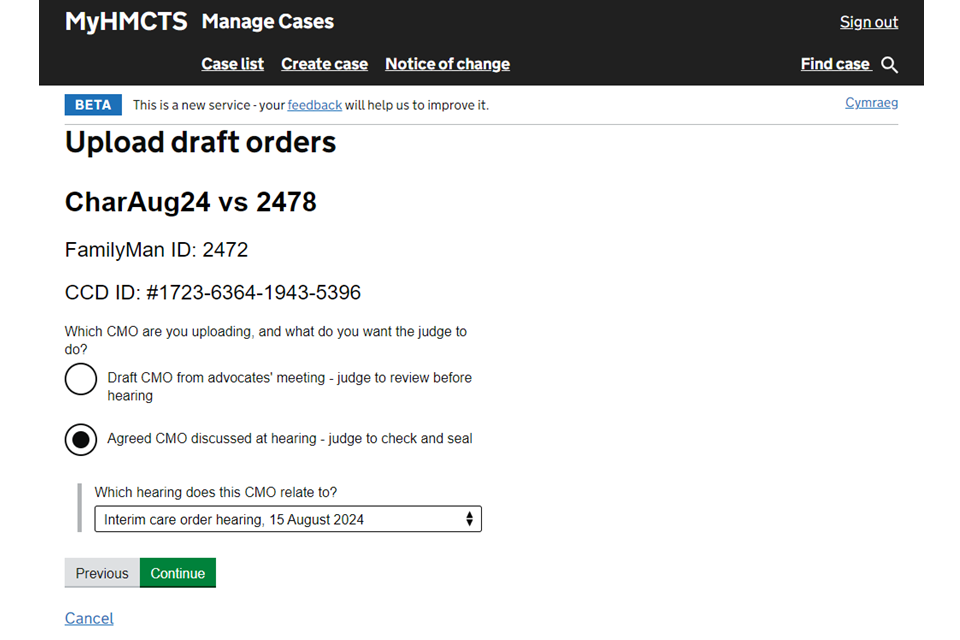
4. Select ‘Choose file’ to browse for the agreed order. If it has not changed from the draft you can upload the same order, but it must be named ‘Final CMO’, not draft. You must also check the box to confirm the document is related to the case. Then select ‘Continue’.
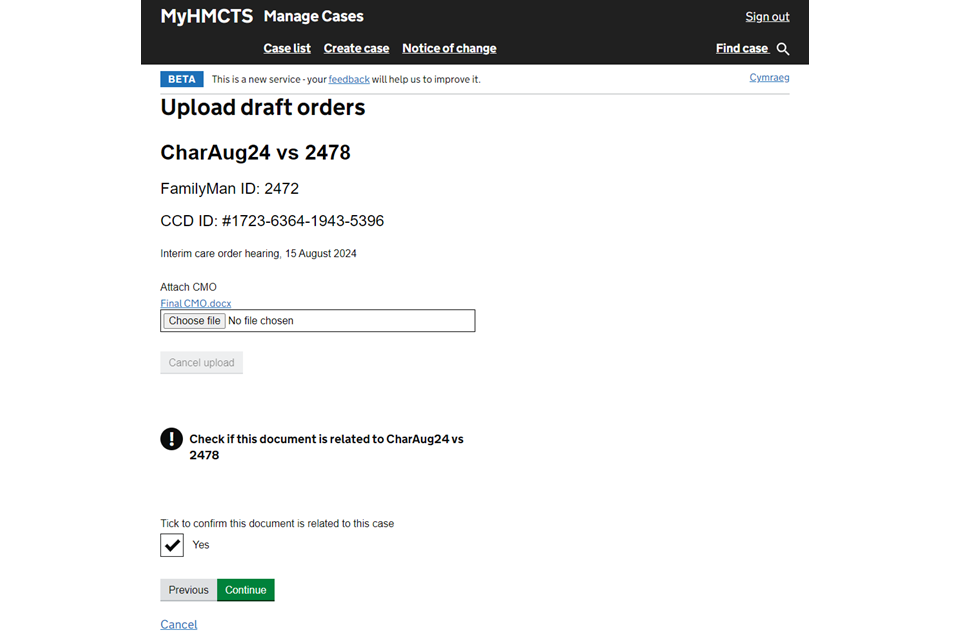
5. If you selected to add both a CMO and an additional order, you will be asked to upload the additional order. Add the order title then select ‘Choose file’ and browse for the order document.
6. If you have more than one additional order, select ‘Add new’ and repeat the previous step. When all orders are uploaded select ‘Continue’.
Make sure any police disclosure orders containing confidential addresses are uploaded with only the names and dates of birth of individuals and the address is redacted. The order will be approved and sealed – you can serve it on the police with the address details in a separate document.
7. If this order is urgent, check the box to request priority approval.
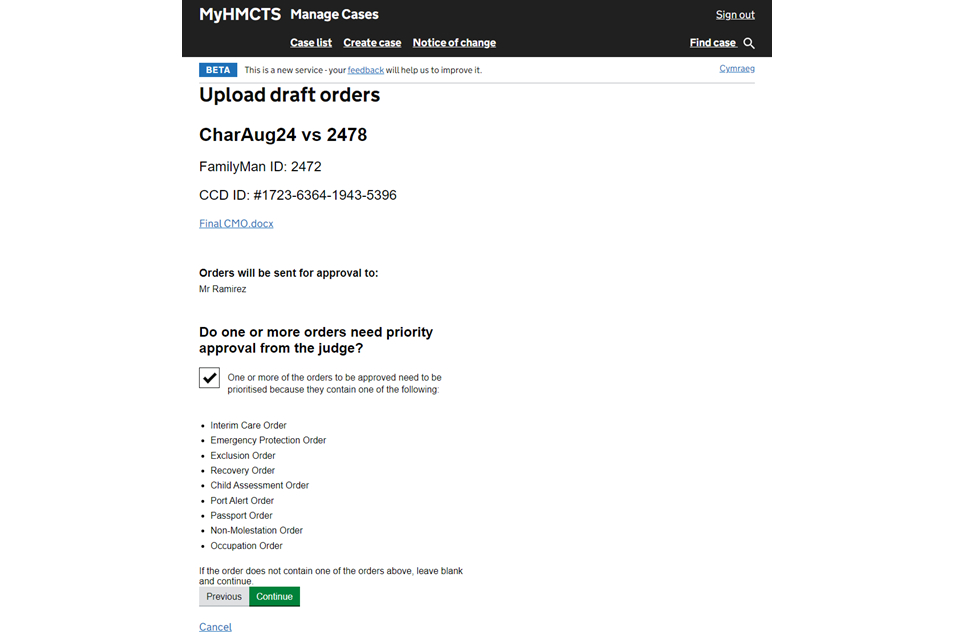
You must only select this if there is an order in the list that needs to be approved urgently. If there is no urgency, leave the box unchecked.
8. Select whether a translation is needed or not. You will see the name of the hearing judge that the order will be sent to. Select ‘Continue’.

9. Check your answers. If you need to make any changes, select ‘Change’ next to the information you need to amend. When the information is all correct, select ‘Submit’.
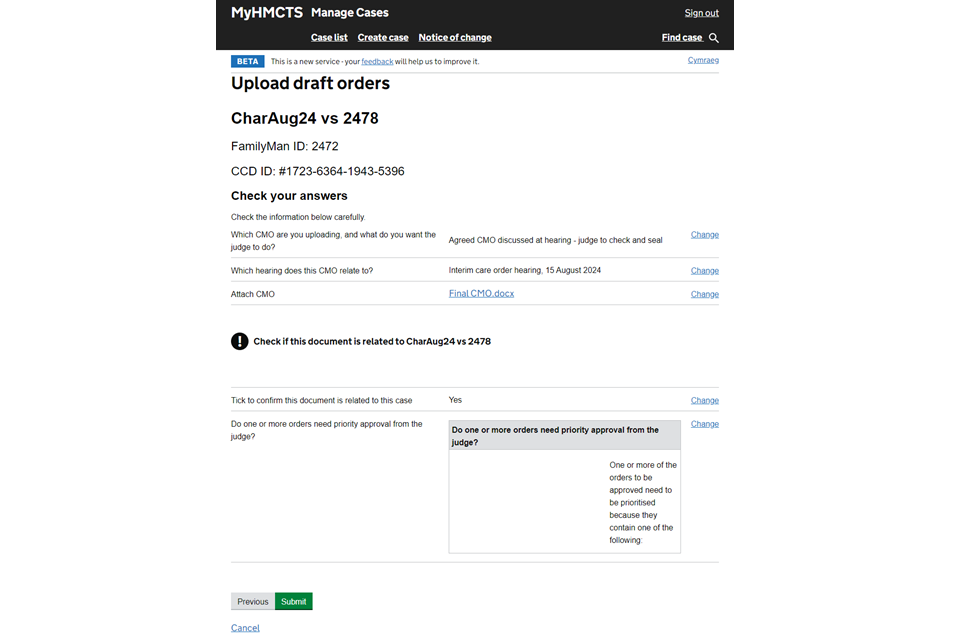
The hearing judge will receive a notification telling them the agreed order is available to view and approve.
Once approved, the order will automatically be sent to the parties – this does not require any action by court staff. Therefore you must make sure that anything you upload is allowed to be served on all parties.
3. Upload other orders
Department for Work and Pensions
If you need to apply for a Department for Work and Pensions (DWP) order, you have 2 options:
- include a direction in the CMO – the court and tribunal service centre (CTSC) will then generate a standalone order, or
- make a separate DWP order application after the hearing
Home Office
If you need to apply for a Home Office order, you’ll need to make a separate application after the hearing. You’ll need to upload a completed EX660 form as a draft order for the judge to approve.
Find out how to upload a draft order
Production orders
If you need to apply for a production order, you have 2 options:
- include a direction in the CMO providing the name and date of birth of the prisoner, the prison and prison number (if known) and whether the hearing should be in person or by video, or
- make a separate production order application after the hearing
4. Upload a court bundle or case summary
Upload a court bundle
1. Open the case and select ‘Manage documents’ from the next step dropdown menu. Then select ‘Go’.
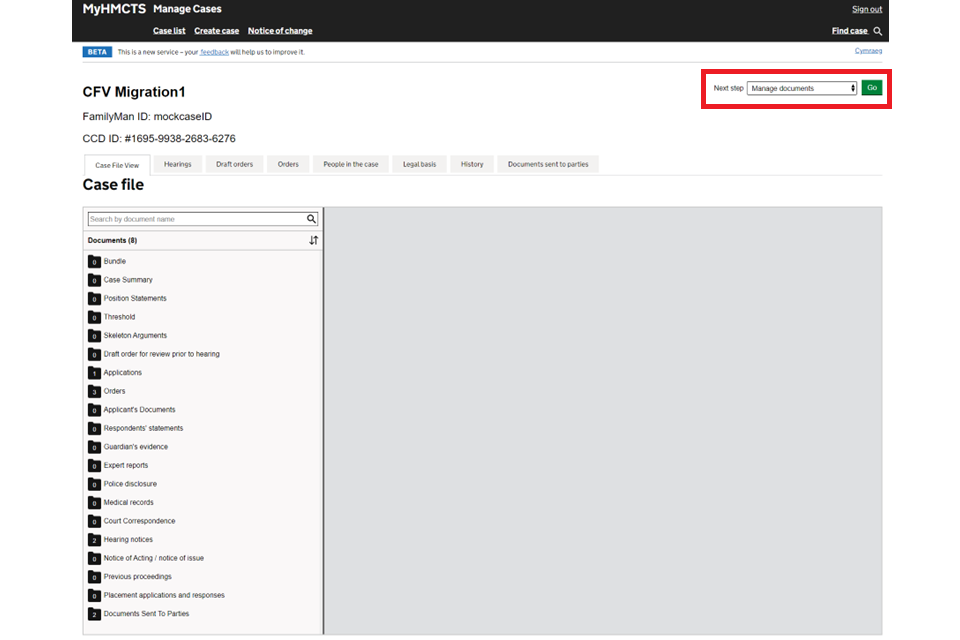
2. Select ‘Upload new documents’. Then select ‘Continue’.

3. Select ‘Choose file’ and browse for the bundle. Then select ‘Court Bundle’ from the document type dropdown list.
You should name the document with the document type, the name of the related person and the role of the related person. For example, ‘Bundle_LA_Applicant’.
4. Select ‘Yes’ if the documents are confidential and must be restricted to the local authority, Cafcass and HMCTS.
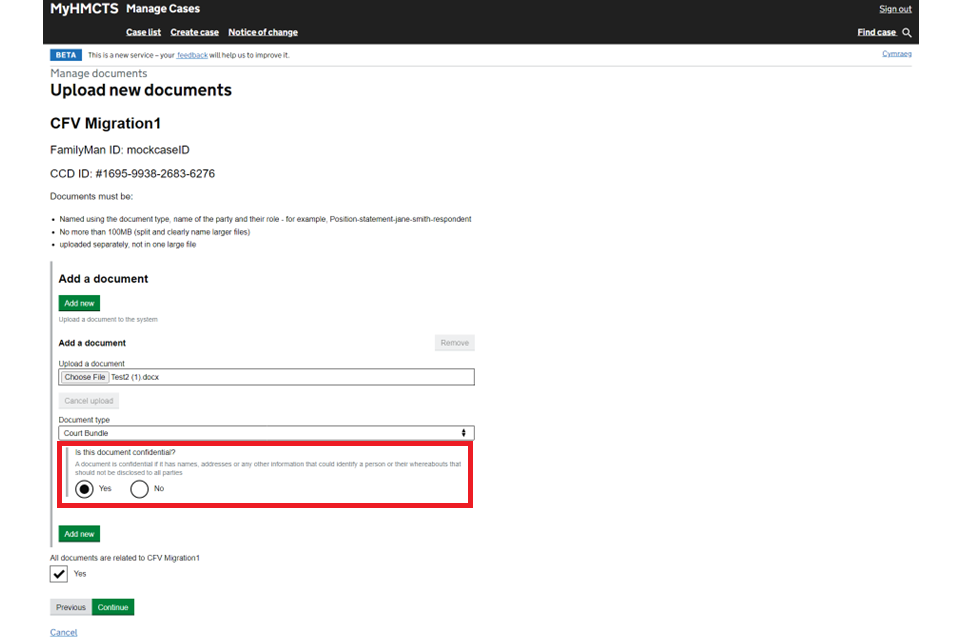
You may need to add another bundle. For example, if you need to include a redacted version or have separated a larger bundle into 2 parts.
5. To add another bundle, select ‘Add new’ and repeat steps 3 and 4.
6. When you’ve added everything, check all documents are related to this case and tick ‘Yes’. Then select ‘Continue’.

7. Check your answers. If you need to make any changes, select ‘Change’ next to the information you need to amend. When the information is all correct, select ‘Save and continue’.
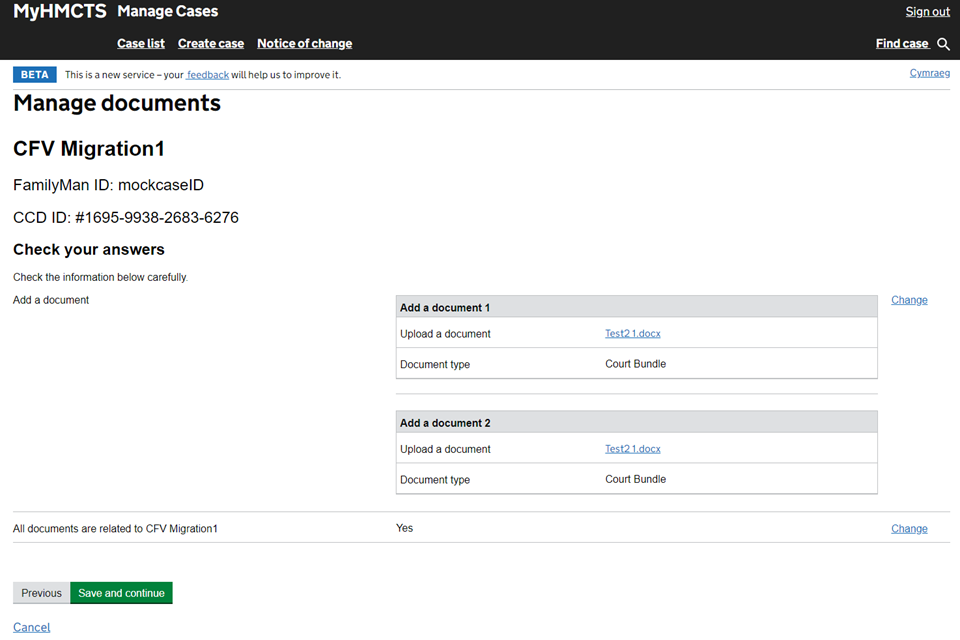
Upload the case summary
1. Open the case and select ‘Manage documents’ from the next step dropdown menu. Then select ‘Go’.

2. Select ‘Upload new documents’. Then select ‘Continue’.

3. Select ‘Choose file’ and browse for the document. Then select ‘Case Summary’ from the document type dropdown list.
You should name the document with the document type, the name of the related person and the role of the related person. For example, ‘Case-summary_LA_Applicant’.
4. Select ‘No’ if the documents are not confidential. If selected, the document will be served on all parties.
5. Check all documents are related to this case and tick ‘Yes’.
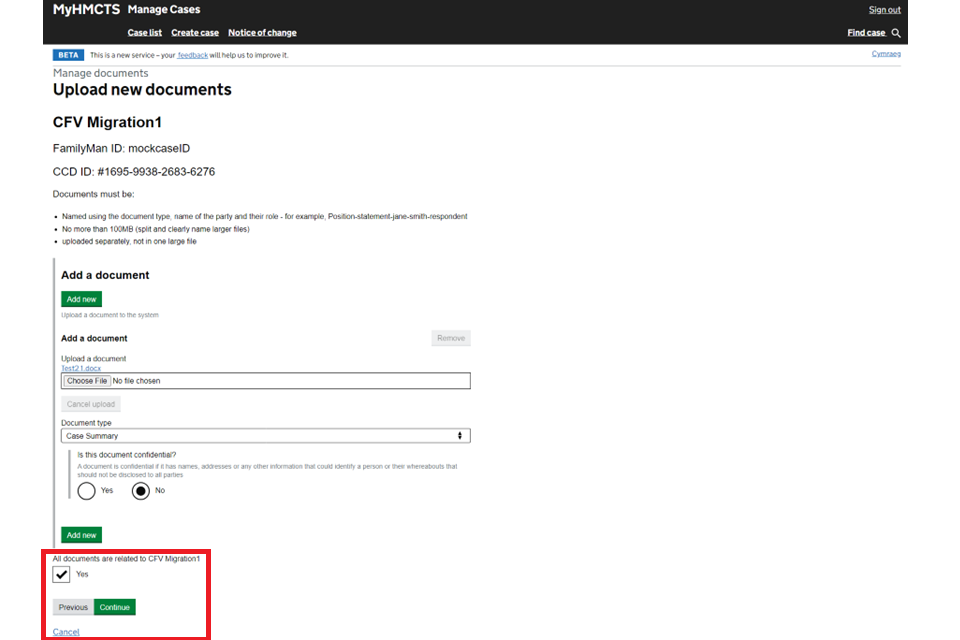
6. Check your answers. If you need to make any changes, select ‘Change’ next to the information you need to amend. When the information is all correct, select ‘Save and continue’.

7. You will find the court bundle and the case summary in the case file.
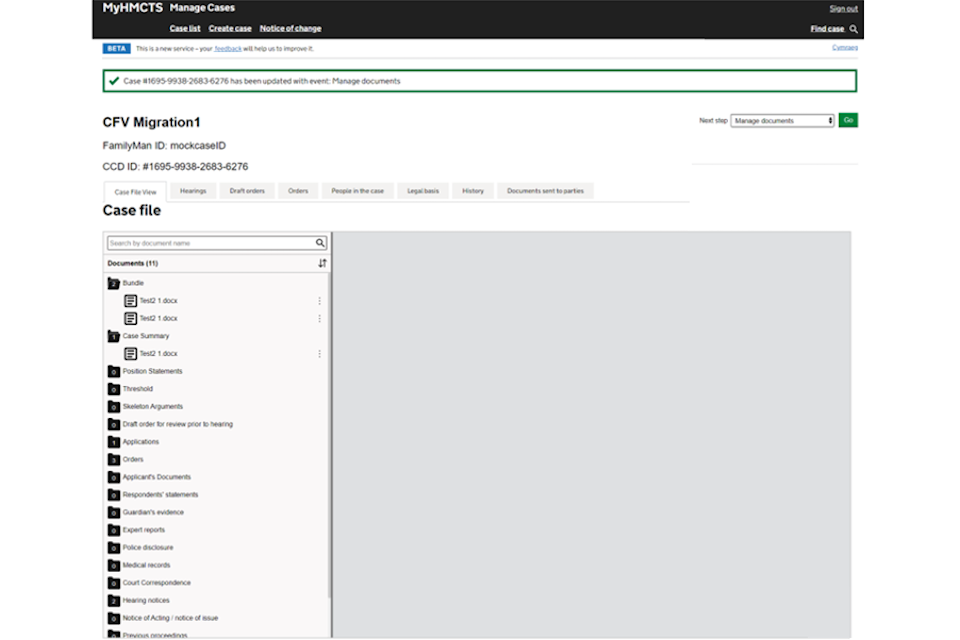
5. Upload further evidence
1. Open the case and select ‘Manage documents’ from the next step dropdown menu. Then select ‘Go’.

2. Select ‘Upload new documents’. Then select ‘Continue’.

3. Select ‘Choose file’ and browse for the document. Then select document type from the dropdown list.
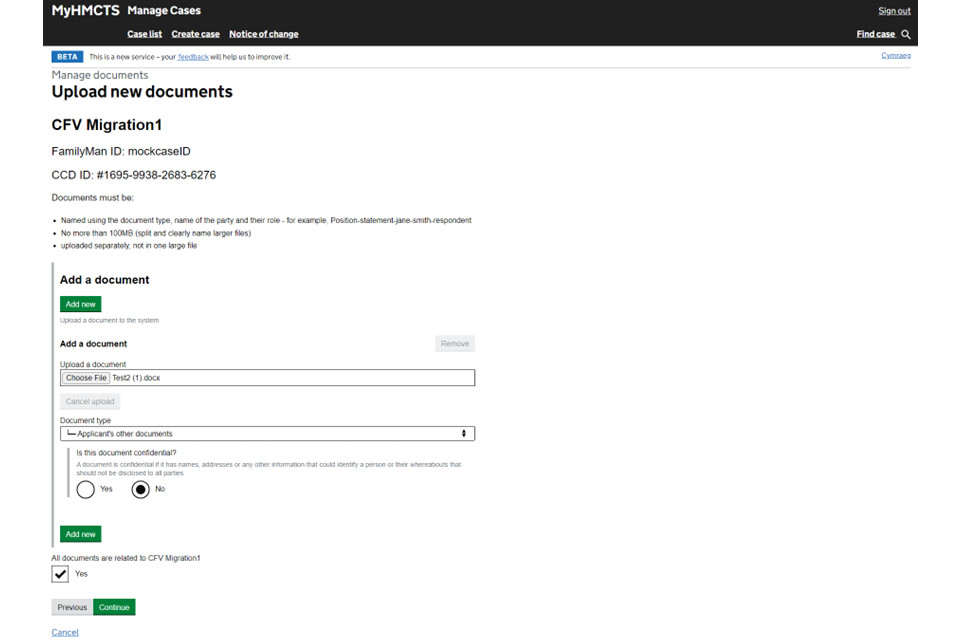
4. Select ‘Yes’ if it is confidential. Make sure that the document you upload has no confidential addresses or other details in it. Anything that is not confidential will be automatically served on all parties.
5. If you need to add more documents, select ‘Add new’ and repeat steps 3 and 4. When you have added all documents, select ‘Continue’.
6. Check your answers and make any changes if necessary. Then select ‘Save and continue’.
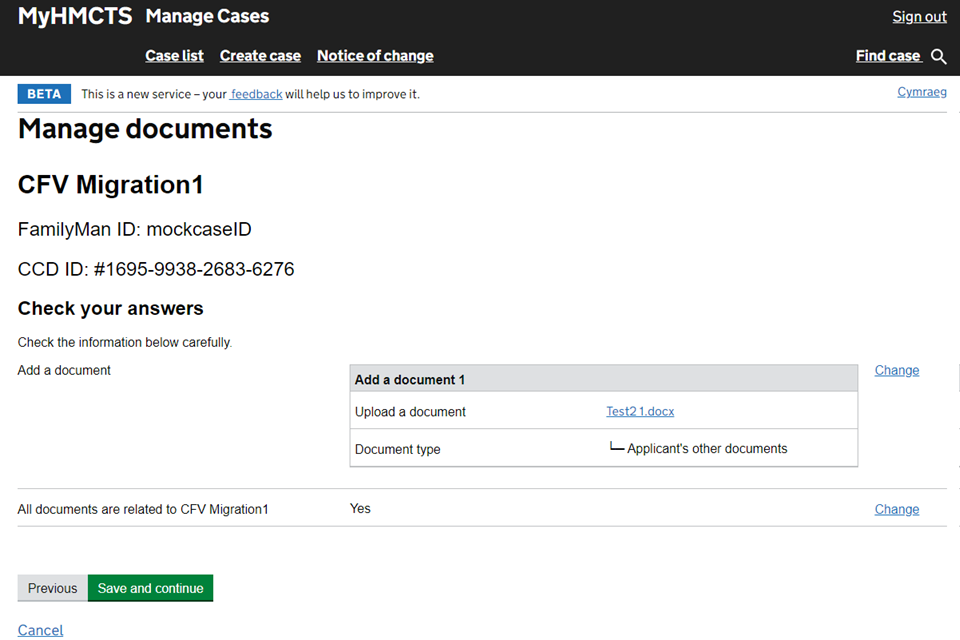
7. You can find the document in the case file. If you have selected that the document should remain confidential, it will be marked as such and only the judge, the local authority and Cafcass will be able to view it.
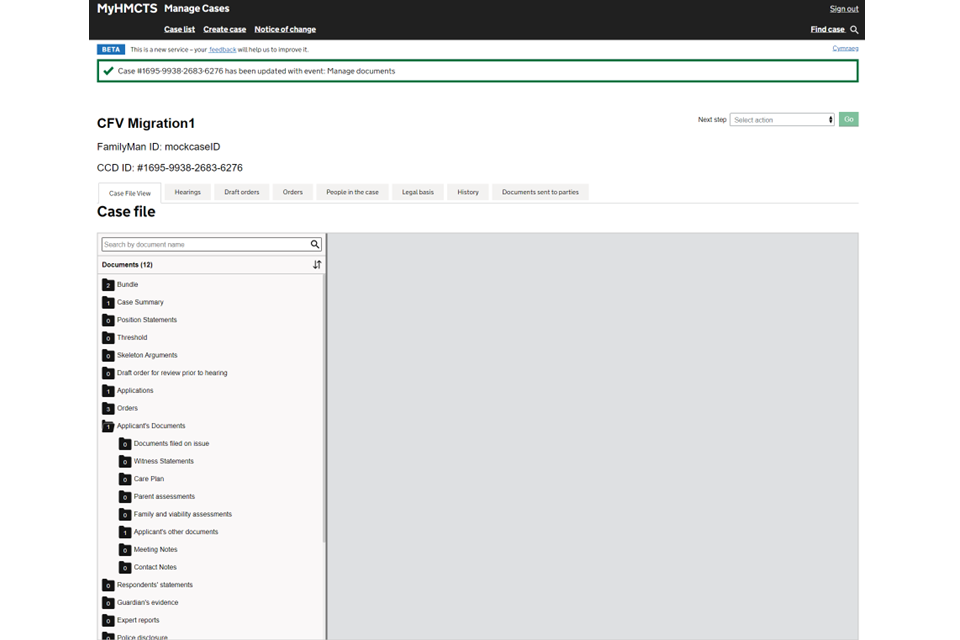
All respondents who are represented will receive an email about the document upload. Where they are not represented, it will be sent by post. When the respondent’s legal representative uploads a document, you will receive a notification.
6. Remove a document or draft order
Remove a document
You can remove a document if you have uploaded it in error. However, do not remove if it:
- was uploaded to the wrong case
- contains a confidential address
In these circumstances you should instead email contactfpl@justice.gov.uk.
If you need to remove a Cafcass document, you’ll also need to contact your local Cafcass office.
Even if the document is removed immediately after uploading, it will still be served to all respondents. Therefore you must email contactfpl@justice.gov.uk if the parties are not allowed to see this document (we may be able to stop any documents being served by post if informed immediately).
1. Select ‘Manage documents’ from the next step dropdown menu.

2. Select ‘Remove documents’ then ‘Continue’.
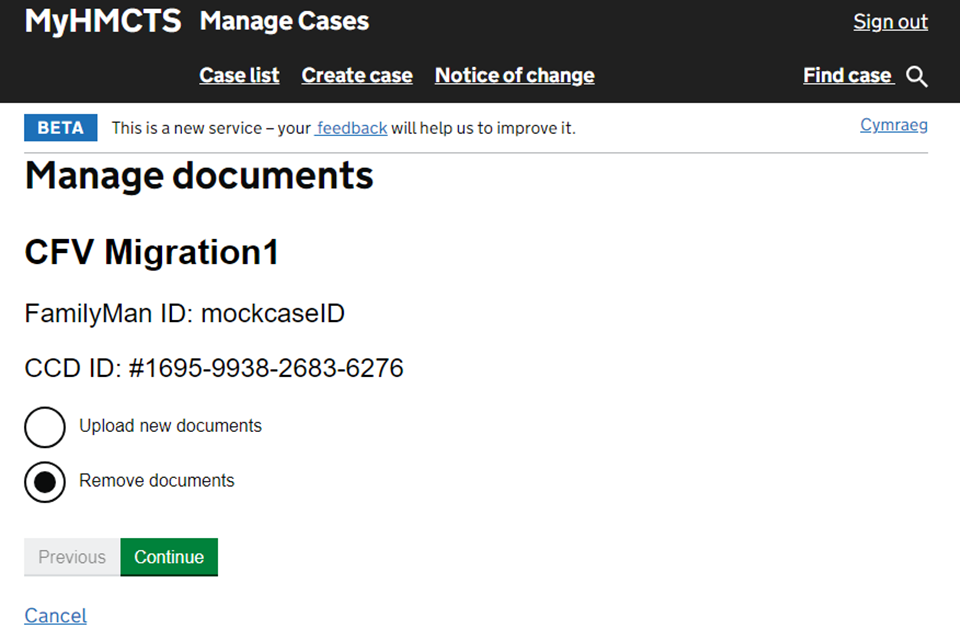
3. Select which document you wish to remove from the dropdown menu. Then select the reason and ‘Continue’.

4. Check your answers are correct. Then select ‘Save and continue’.
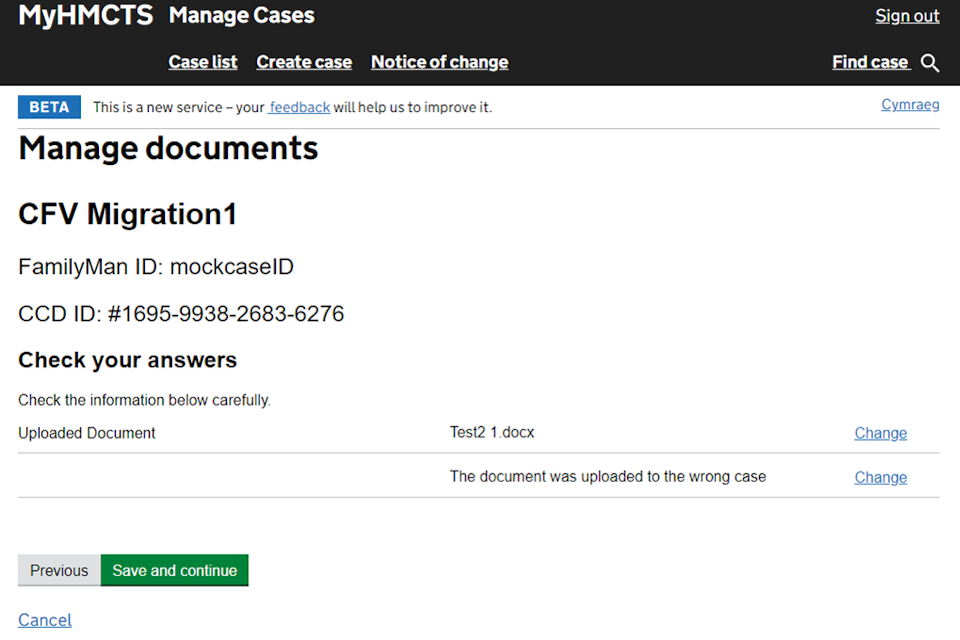
The document will no longer appear in the case file. The removal will be logged under the ‘History’ tab with details of the user, date and time.
If you need to replace the document, you should then upload the document using ‘Manage documents’ and ‘Upload document’.
Remove a draft order
You must email contactfpl@justice.gov.uk if you are removing the draft order because of a data incident. This will need to be reported and checked to make sure it was not accessed.
1. Select ‘Remove draft orders’ from the next step dropdown menu. Then select ‘Go’.
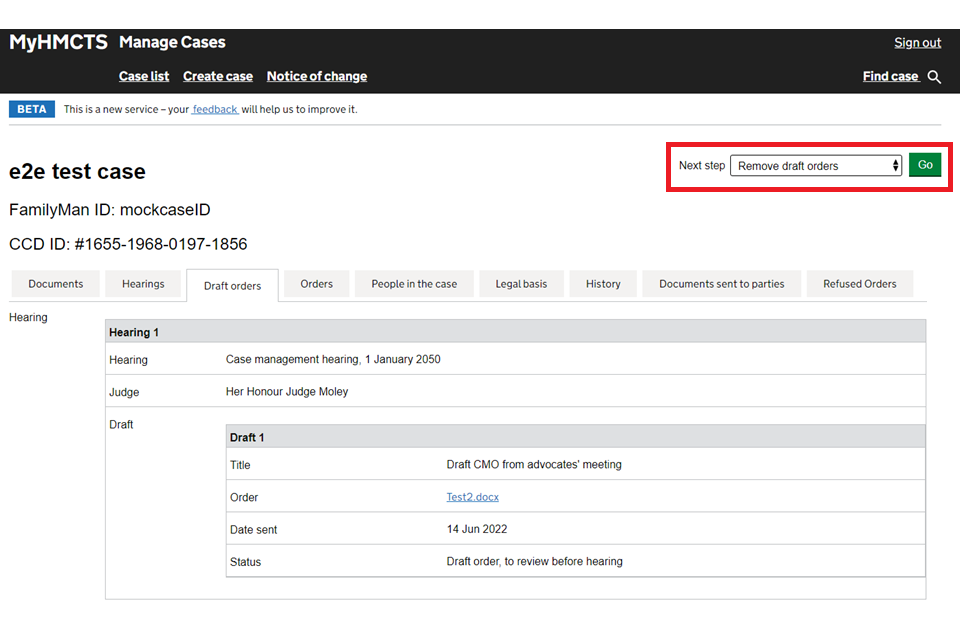
2. Choose the draft order you want to remove. Check it is the correct draft order if there is more than one. Select ‘Continue’.

3. Explain why the order is being removed, then select ‘Continue’.

4. Check your answers are correct and select ‘Submit’.

5. The order will be no longer be in the draft order tab. The judge or legal adviser will be updated.
7. Get help with MyHMCTS
Managing cases and case access in MyHMCTS
For help with technical issues using MyHMCTS to manage a family public law case, email FamilyPublicLawServiceTeam@justice.gov.uk.
For support or guidance on a case, email the court and tribunal support centre (CTSC) at contactfpl@justice.gov.uk or call 0330 808 4424.
If you need to arrange for special measures at the hearing, you should contact the CTSC as soon as possible.
Find guidance for case administration tasks in MyHMCTS
Accessing your MyHMCTS account
If you are having trouble accessing MyHMCTS, make sure you are using the correct link. To manage a case, you must use https://manage-case.platform.hmcts.net.
You should also make sure you:
- check your internet browser is up to date – we recommend you use Google Chrome or Microsoft Edge (you cannot use Internet Explorer or Apple Safari)
- clear your cookies and your cache
- check your firewall and security settings
We recommend that you bookmark or favourite MyHMCTS in your internet browser. You should only create the bookmark or favourite once you have signed in and are on the homepage. Do not create it from the sign in or verification pages, or while you have a case or organisation open.
If you are still having trouble accessing MyHMCTS, try using a different device to sign in.
If you have an IT support team, they will be able to help with any device, browser and security issues.
If you have an issue with your MyHMCTS account, you should contact an account administrator in your organisation.
If you need additional support with your MyHMCTS account, including with verification codes, email MyHMCTSsupport@justice.gov.uk. We aim to respond within 5 working days.
